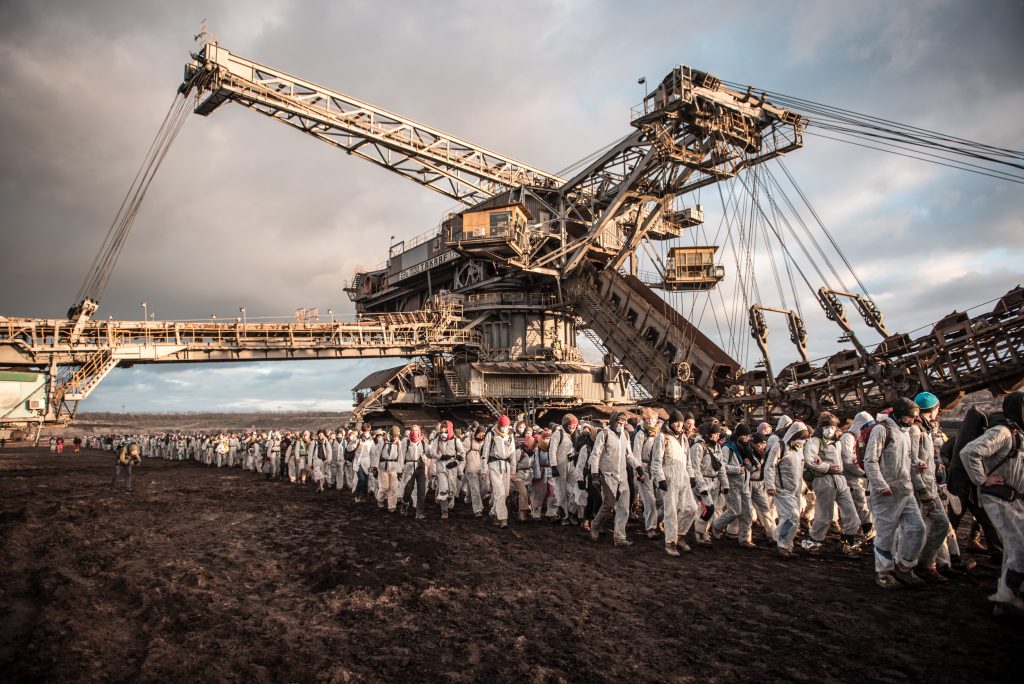
Along with Hambacher Forst, and now Extinction Rebellion Deutchland, Ende Gelände is the largest and most well known group dedicated to climate activism in Germany. Like Extinction Rebellion, its method of activism is civil disobedience – non-violent direct action. But instead of blockading city streets, its takes the struggle to the front lines of the ecocide – storming the various open cast mines that scar the German countryside, in an attempt to disrupt the destruction for a while. The visuals of the action are striking. The earth ripped open, devoid of life, towered over by steel giants. A group of lonely human beings protected from the dust storms by paper gas masks and hazmat suits approaching this ravenousness beast. Another group of humans, armoured in black, standing between them and the machine. With images that look more like something out of a sci-fi film than the 9 O’clock news, the movement has caught the attention of all sides of the German media.
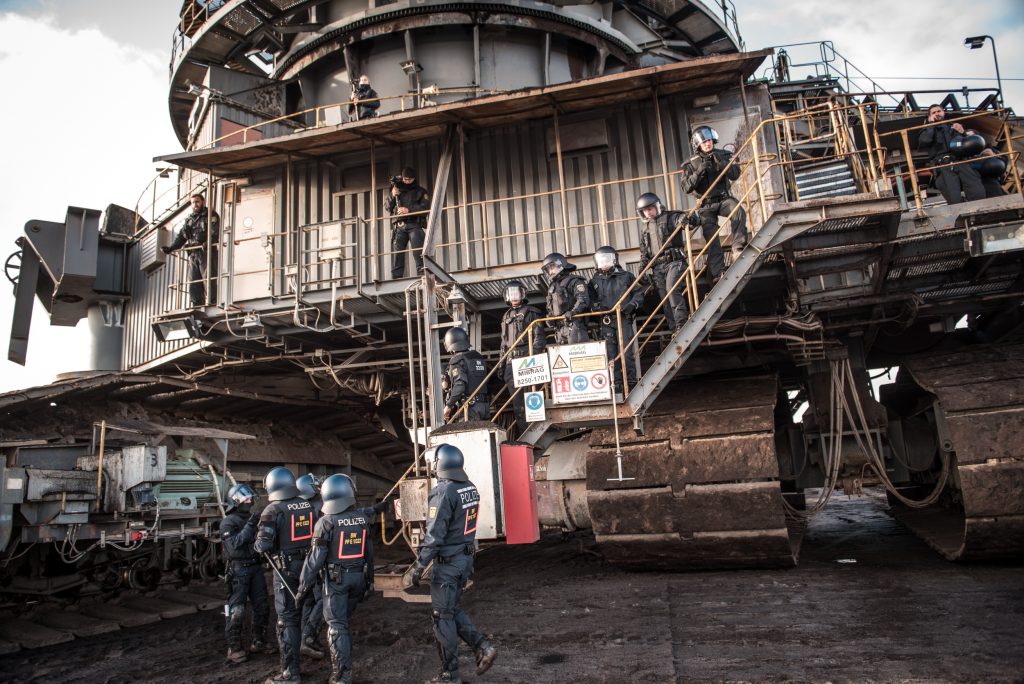
In the days between autumn and winter, Ende Gelände organised an action in Lausitz, close to the Polish border. Normally, the actions are proceeded by a camp, close to where the action is taking place, and from there the organisation and training take place. But with the frost starting to take the countryside in its icy grip, it was decided that the action would be organised from the cities of Leipzig, Berlin and Dresden. Happy for an excuse to dip my toes once more in the Berlin chaos, I booked my bus back to Babylon.
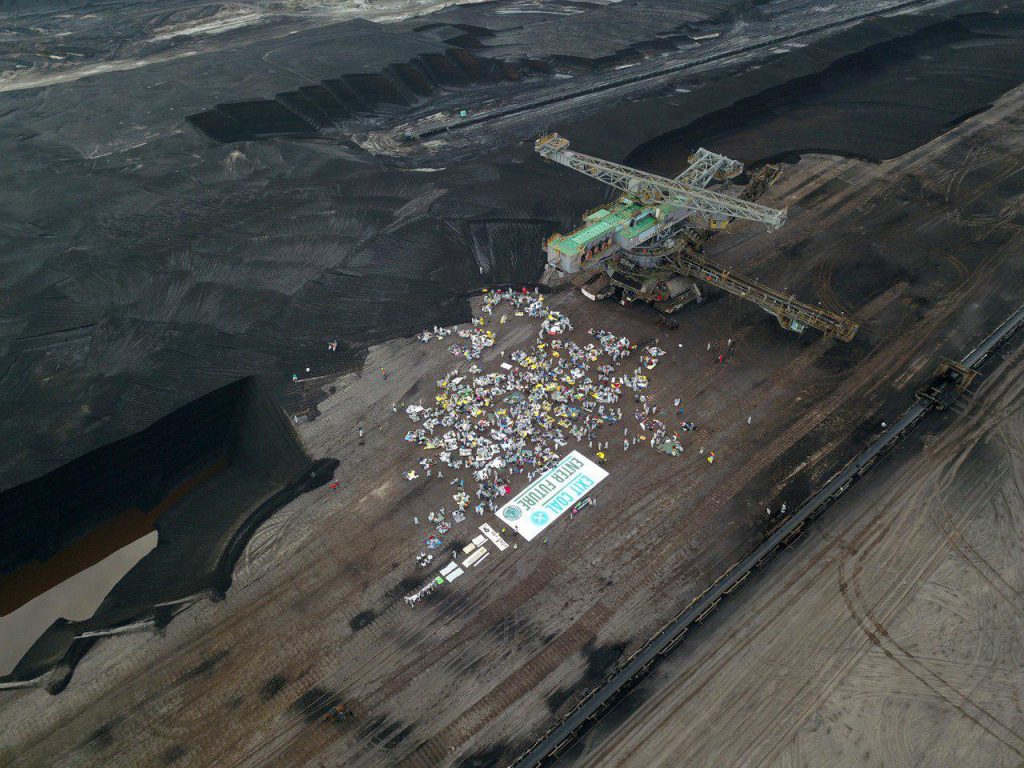
History of Ende Gelande
The year is 2019 and the earth is burning. Toxic gases released into the air choke the winds. Wild fires blaze over areas the size of continents. Far from trying to put this fire out, human beings can’t even stop themselves from pouring petrol on it. In Germany coal remains the largest source of electricity. As of 2016, around 40% of the electricity consumed in the country is generated from coal. Germany is also a major producer of coal, with coal production accounting for 35% of all energy produced in 2018. As this coal was often deep under the ground and geologically complicated to access, 337 billion euro of public funds have gone into subsidizing the coal mining industry between 1970 and 2016.1 The scale of this is a little difficult to comprehend, but let’s take a second to reflect upon the criminal nature of this fact. In a time where most people on earth live in abject poverty, and are forced to labour for less than a euro a day, huge coal corporation have received 337 million euro in ‘public’ funds to destroy life and poison the earth.
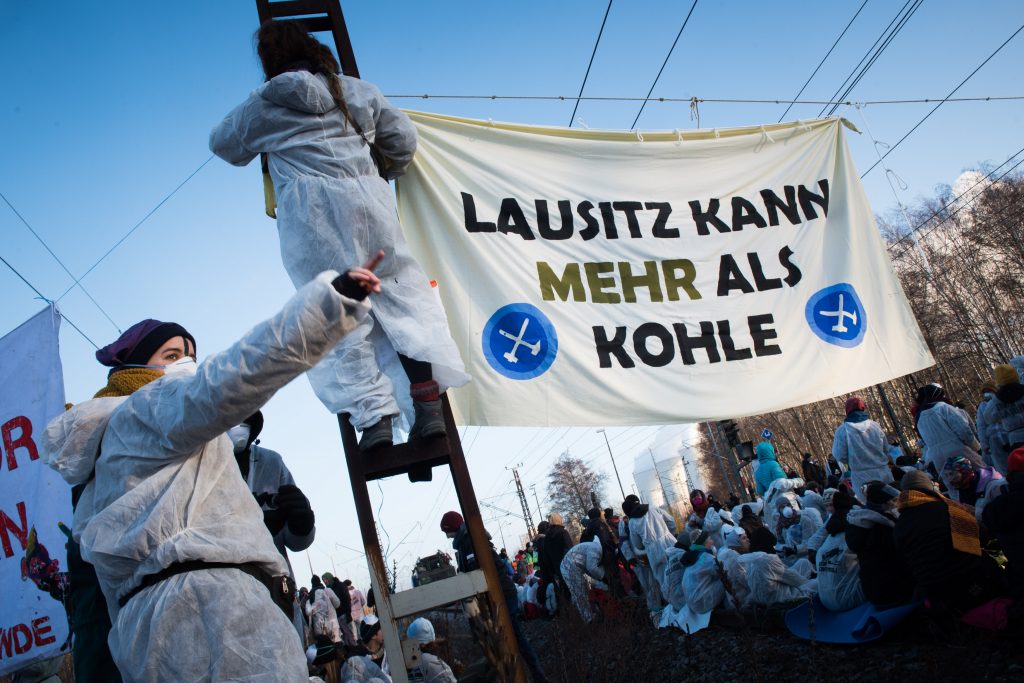
Governments and corporation have proved themselves incapable of taking the necessary steps to ensure the survival of life on earth as we know it; unable to restrain unfettered greed, unable to imagine any alternatives, those who find themselves in the position of oppressor are perhaps the most paralysed of all. Unless challenged, the status quo will continue on its steady course of destruction until there is nothing left. In a situation like this, it becomes the responsibility of those who aren’t as caught up in the logic of the system to imagine something different, to create something different. Sometimes this something different takes the form of creating new ways of living, independent of old networks of violence. Sometimes it entails disrupting old ways of living, disassembling those structures most in need of disassembling. Ende Gelände is a movement dedicated to ending of one of those structures; the fossil fuel industry.
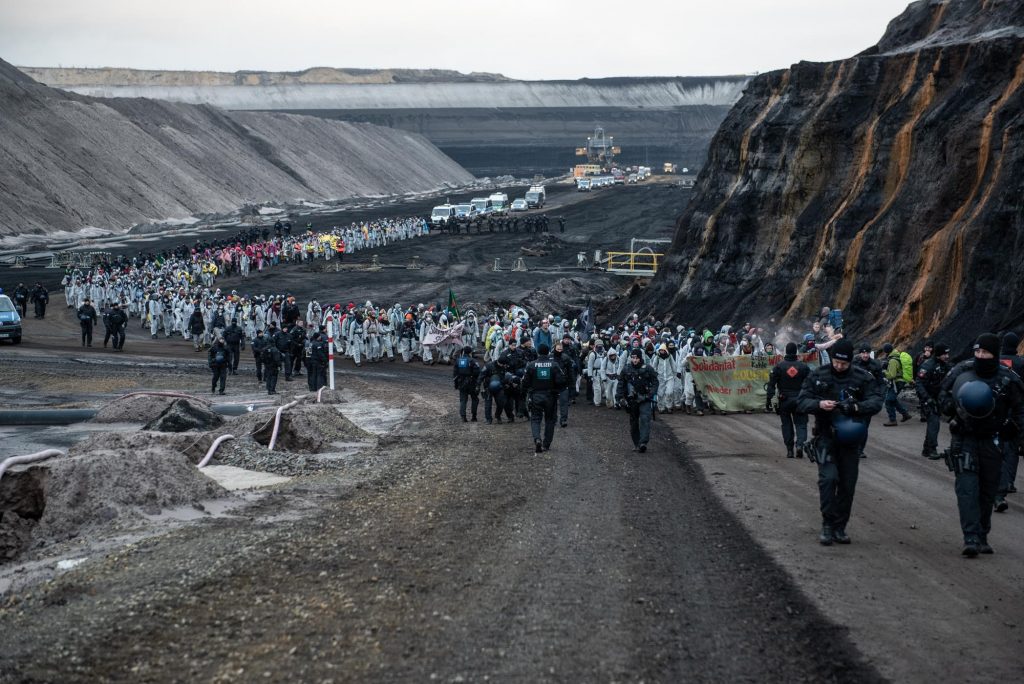
Founded in 2015 from a network of activists from a diverse range of movements (the anti-atomic energy and anti-coal movement, the climate camp of Rheinland and Lausitz, Hambacher Forst, climate policy grassroots initiatives and citizens’ initiatives, and also larger environmental organizations) Ende Gelände has become one of the most important actors in the national discourse on the energy. The aim of the group is the immediate end of the production and use of fossil fuels, as well as the establishment of alternatives for those people whose livelihoods are dependent on the industry. The method of achieving this aim is non-violent civil disobedience, in the tradition of the Indian independence movement, and the US American civil rights movements. In this case, civil disobedience means illegally storming a coal mine in an effort to disrupt ‘production’ (that is to say destruction). The wider philosophy of Ende Gelände is anti-capitalist (with slogans such as ‘there is no such thing as green capitalism’), and intersectional. There is large queer participation, as well as support for people with disabilities. There are also awareness teams and pamphlets dedicated to making the space more open to non-white people (although the movement remains overwhelming white middle class).
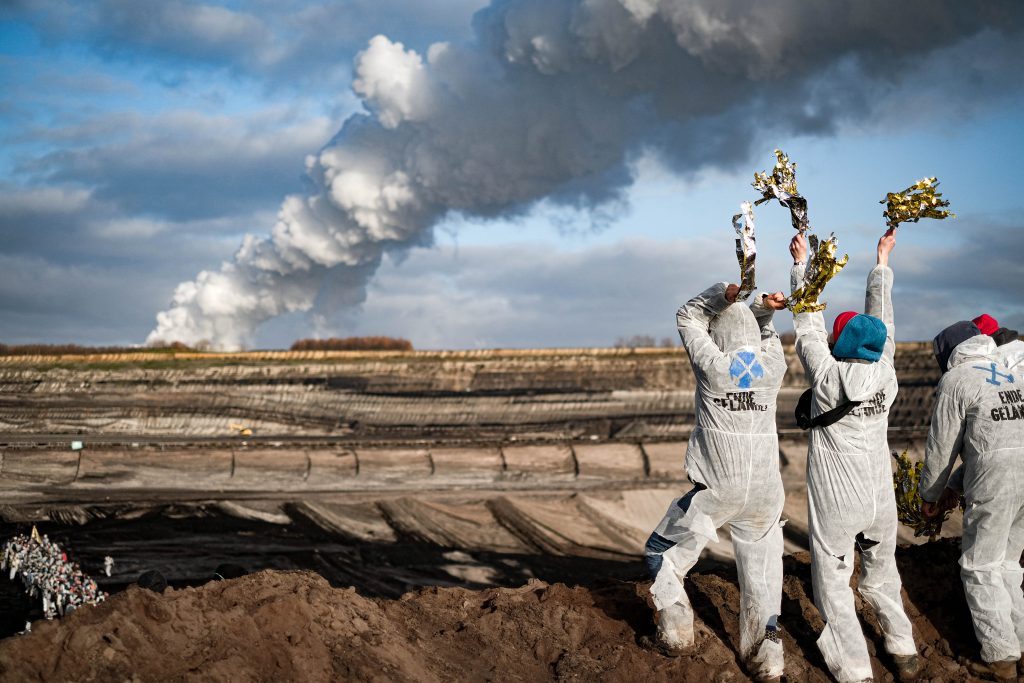
With the distinctive white jump suits and gas masks, participation and media attention has grown year after year. The first action took place in 2015, with around 1500 activists blockading the Garzweiler surface mine over two days. The next year saw 3500 activists blockading the Welzow-Süd open pit mine over course of this three days. During this action coal production was reduced to 20%. By 2017 the number of people willing to put their bodies on the line and storm a mine in the Rheinland coalfields rose to 6000. 2018 saw activists disrupt production in the mine by the Hambacher Forst, and summer 2019 again saw actions in the Garzweiler surface mines. Over the years the movement has slowly rose to the forefront of political discourse, and in 2019 the German government created the Kohleausstieg Kommission (Coal Exit Commission) to plan the end of the coal industry in Germany. While a step forward from the previous strategy of burying their heads in the sand, the Commission For Dragging Out the Coal Exit for as Long as Possible, committed Germany to coal production for the next 20 years. Essentially, they’re going to mine all the coal they know about, then, when there’s nothing left, they’ll stop. In a world in which many are already feeling the effects of climate change, this response is wholly inadequate. In winter 2019, with schoolkids on strike all over the world, and the COP25 about to take place in Madrid, activists once again strapped on the gas mask, bracing the winter coal to disrupt the normal functioning of the coal industry for another day.
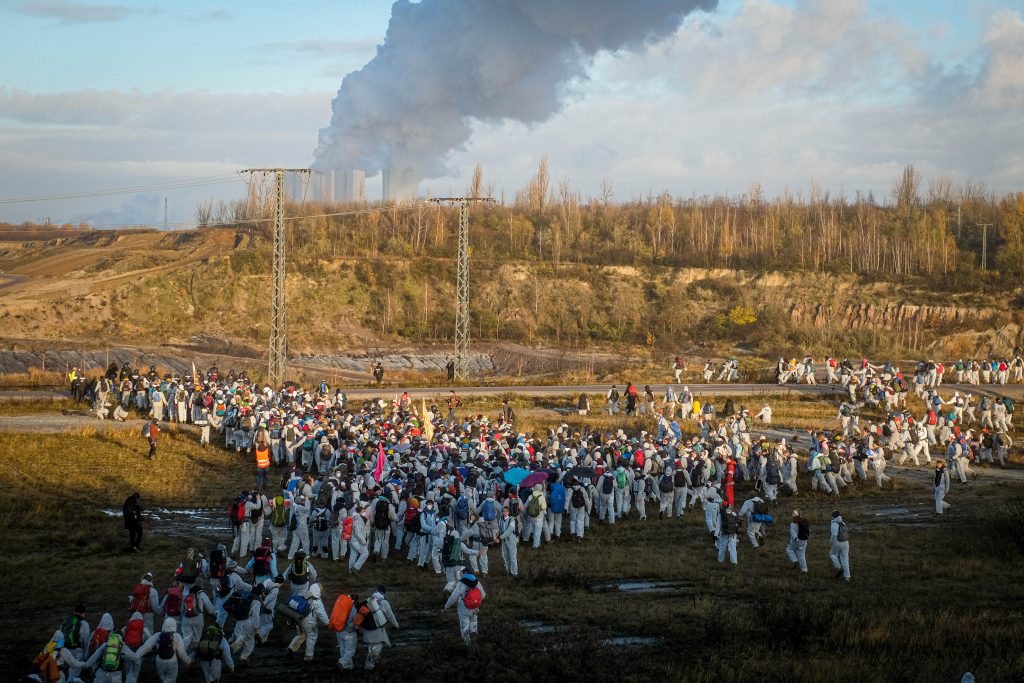
Before
Arriving into the city of Berlin, I was filled with the excitement of the endless possibilities the city offers. After a few months on eco-villages or in the forest, you get used to the simple pleasures of life, and by the end of the day things grow quiet and you rest. But in the city there is always something happening, always something to do. There are no external limits to enjoyment seeking, so people often reach their own limits. Many in the city are constantly pushing themselves to this limit and then further by chemically extending it. After a while this lifestyle becomes draining, the endlessly possibilities become either daunting or an escape. Either this or else one manages to find their peace with the city. I wasn’t able to do that, I could find everything else in the city except for peace. The energy of the city took hold of me, pulled me this way and that, until I was forced to flee to the forest to discharge. But returning to the city, I held the peace of the forest close to the chest, and could enjoy the craziness of city for what it is.
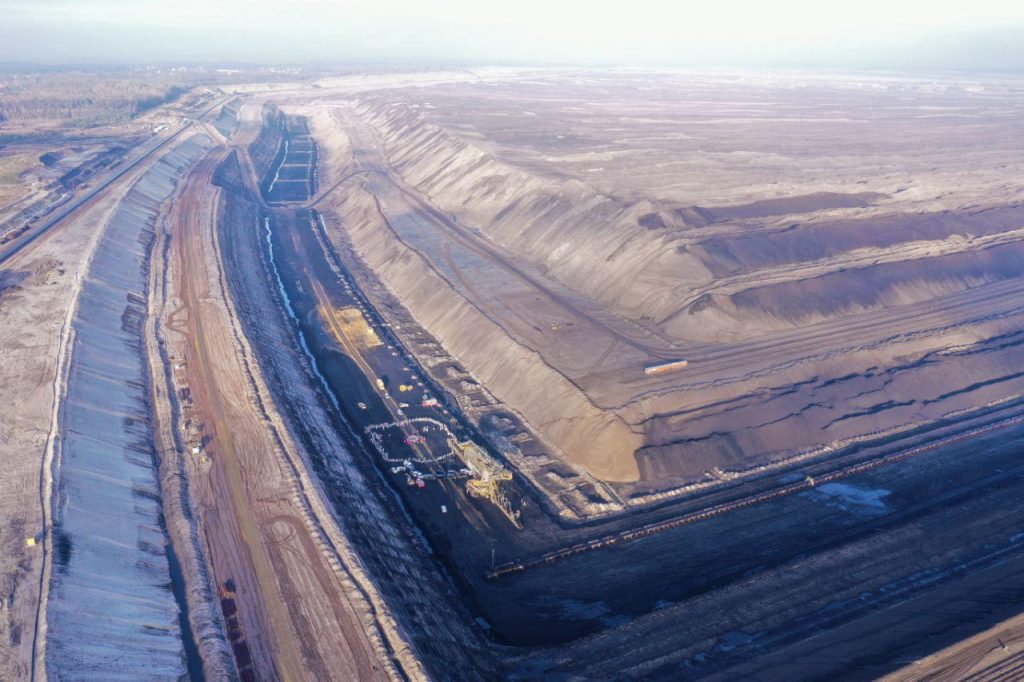
After a few days came the action training day. With the action taking place on the Saturday, we all assembled for the first time on the Friday to learn about the principles and structure of the action, organise ourselves into groups, and learn how to move as a single unit. The training day took place in two locations in the city; Kubiz, a culture and education centre in Weißensee; and Huxley’s Neu Welt, a venue for music and theatre in Neukölln. Friday morning was action training in the Kubiz, and so I made my way over. The Kubiz is a former children’s hospital and, like many places in Berlin, had the feel of a squat or house project. It also had a large auditorium where the action training place. Here we went over what we could expect, and how we should act during the following day’s action. It was organised along essentially the same lines as Free the Soil and so I won’t go everything in detail here but the topics were; the concept of civil disobedience, organising oneself into smaller groups (Bezugsgruppen or affinity groups), one’s legal rights, protecting oneself from police repression, how to create human chains to form a blockade, how decisions are made during the action (consensus), among other topics. Luckily I recognised some people from Lebensgarten Steyerberg who had made their way to the action, so I already had my Bezugsgruppe. After the action training and a bit of lunch prepared by good people of the kitchen, we made our way to Huxley’s Neu Welt for the next stage of preparation. This consisted of two elements; finger training and action plenum.
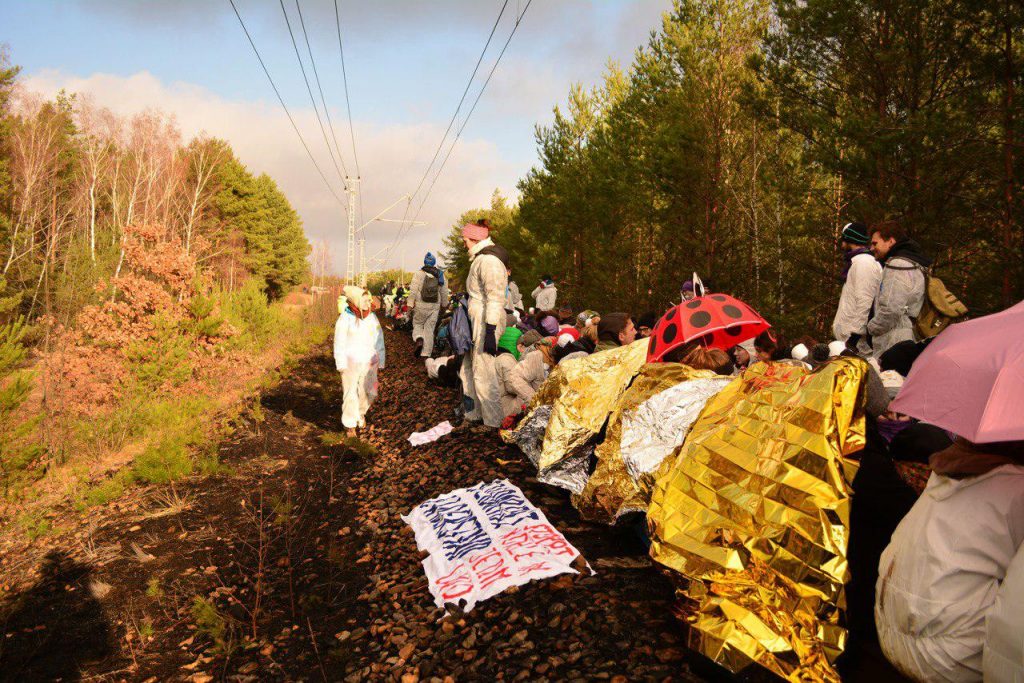
The finger training was also explained in more detail in the text on Free the Soil, but essentially it is training for how to move as a group. During the action we march in rows of six in a long column. The finger training consisted of practising hand signs for a variety of movements and manoeuvres. At dusk in Hasenheide, a large park beside Huxley’s Neu Welt, we trained a number of methods to break through police blockages. Approaching the ‘police line’ you could feel the energy of the group swelling up from the pit your stomach, finding release in the rush past the ‘police’ who were overwhelmed by sheer number. Aside from the training aspect, it was an exciting example of the power of numbers. After we went back to the action plenum. This was important as it was the first time it would be announced when and how we would get to the Lausitz the following day. This would be different for different fingers, so first we organised into our separate fingers. Sometimes the fingers are organised according to the level of risk you are prepared to engage in, with some fingers being more high risk than others, but this times the levels of risk were essentially the same, so we all organised according to which colour we liked best. Joining the orange-purple finger, we assembled outside to find out that we would all be meeting the following morning at 5am. As it was already late, we made our way home to get as much sleep as we could before the action.
Oh Berlin, oh Sodom, oh Gomorah,
oh you lands of joy and excess,
how excitement fills your streets,
fills the people roaming your streets.
On the prowl for the next thrill,
the next buzz and whur,
that place of heady ecstasy.
Little worlds,
oblivious to all beyond the dreamy white gates,
losing the scent of the air,
the sight of the sky.
The end is nigh,
so we all must dance,
Dionysus sits atop the pantheon.
Action
Waking up in the earliest hours of the morning, activists all around the city began to collect themselves and make their way to the train station Ostkreuz. Still dark and cold, a few hundred people huddle close on a small platform. We move from one platform to another, maybe in a manoeuvre to confuse potential police. After a while it is announced that the next train is the one we are getting on. After we get on the two storied Deutsche Bahn train, there is a palpable excitement in the air. I am still tired and so I lay my head against the seat beside me and rest. People are drawing slogans or pictures on their gas masks and playing ‘guess who’. Thankfully we didn’t see any ticket inspector, as this would have been a terrible start to the day for them. The sky turns from black, to dark blue, to red, then pink. A ‘mic check’ is echoed through the train, signalling that a message is about to reverberate through the group; ‘suits on, we are getting off at the next train’, we listen and repeat.
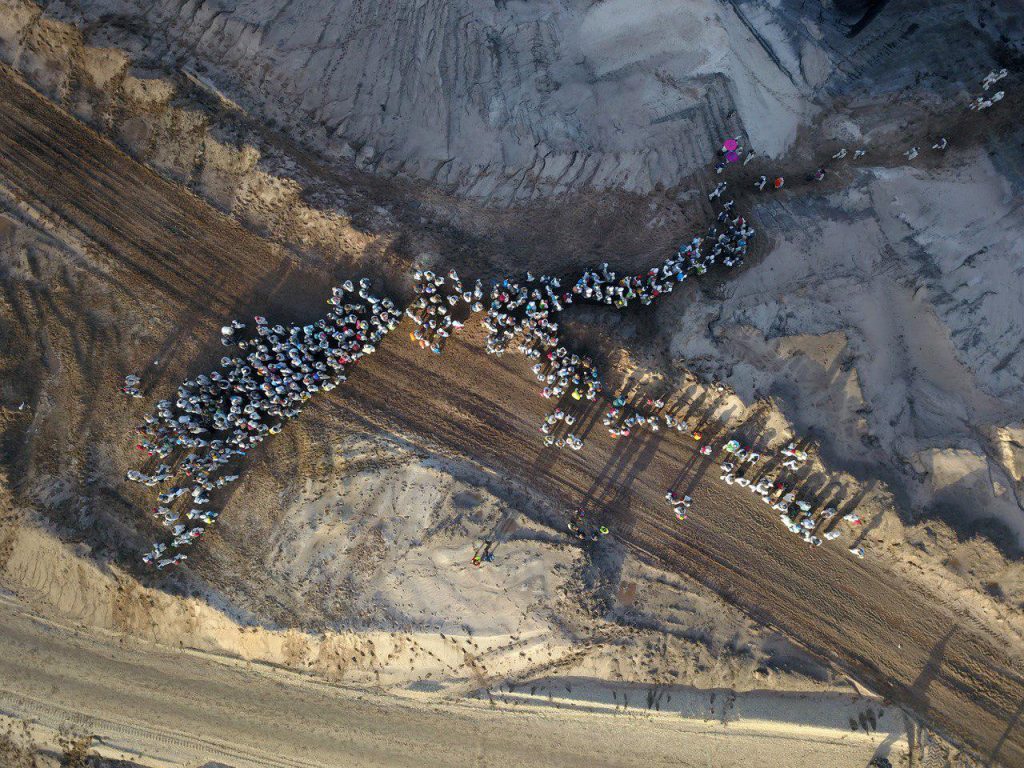
We get off the train in the middle of nowhere. To our left and right are large industrial fields, in the distance are pine plantations. We form the finger and get moving. The sky is clear and blue, with only one large cloud hanging over the trees. As we begin to move through the fields we see that this cloud is coming the ground, tonnes of CO2 streaming into the air. People break away from the finger and begin to relieve themselves; ‘wir machen keine Pipi Pause, bleibt im Finger!’ (we aren’t taking a piss break, stay in the finger!’). A police van suddenly appears along the road we are crossing. Three police get out and begin to follow the finger. Against 400 people they can do nothing but plead ‘hey, don’t go there’, or inform us ‘you know, this is illegal’. After about 40 minutes we cross some bushes and reach a few lines of train track. These are the tracks going in and out of the mine. We begin to march along the tracks; ‘hey, there are trains using these tracks, you shouldn’t be walking there’. The road is rocky, so I walk balancing along the tracks. Despite this one of my shoes comes apart at the seams. Luckily an Italian friend in the Bezugsgruppe had a spare pair. I swap my shoes and we catch up with the rest of the Bezugsgruppe, who were near the front of the finger. We reach a point where five tracks meet, and it is announced that we have reached our goal, and we should make ourselves comfortable.
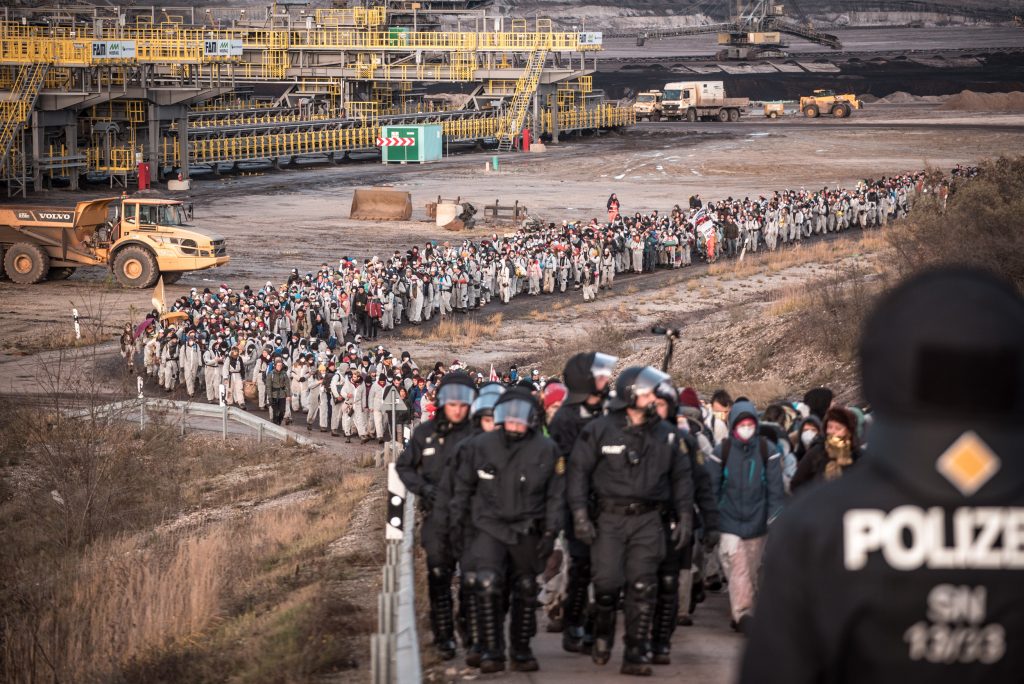
As we all spread out and sit down on the tracks its unclear if the police would attempt to move us. More police appear up the tracks, three police become ten. Suddenly, five police vans pull up in the street along the tracks and we are surrounded by a large gang of them. I am unsure of what will happen and mentally prepare myself for a human chain, but most other people seem calm – so calm that they start taking tea and sandwiches out of their bags. Others start playing games, juggling and dancing. Chants rise into the air (‘aufgeht’s, abgehts, Ende Gelände’/ ‘Wir sagen Kohle, ihre sagt Stopp, Kohle, Stopp! Kohle, Stopp! Kohle, Kohle, Kohle, Stopp Stopp Stopp!’) A train loaded with coal approaches us from the side of the coal mine. It comes right up to the blockade before stopping. A police man explains the situation and the train turns around. The call goes up that there will a plenum under the purple flag in ten minutes. As we all gather we realise there is not so much to discuss. We have reached our goal. The only problem was that as it was so unexpectedly easy that we must somehow create the feeling of euphoria without the fun of charging through police lines. They say that if anyone has any workshops or anything to offer it would be great. It was a bright sunny day, but cold, and a bit of movement would do everyone good.
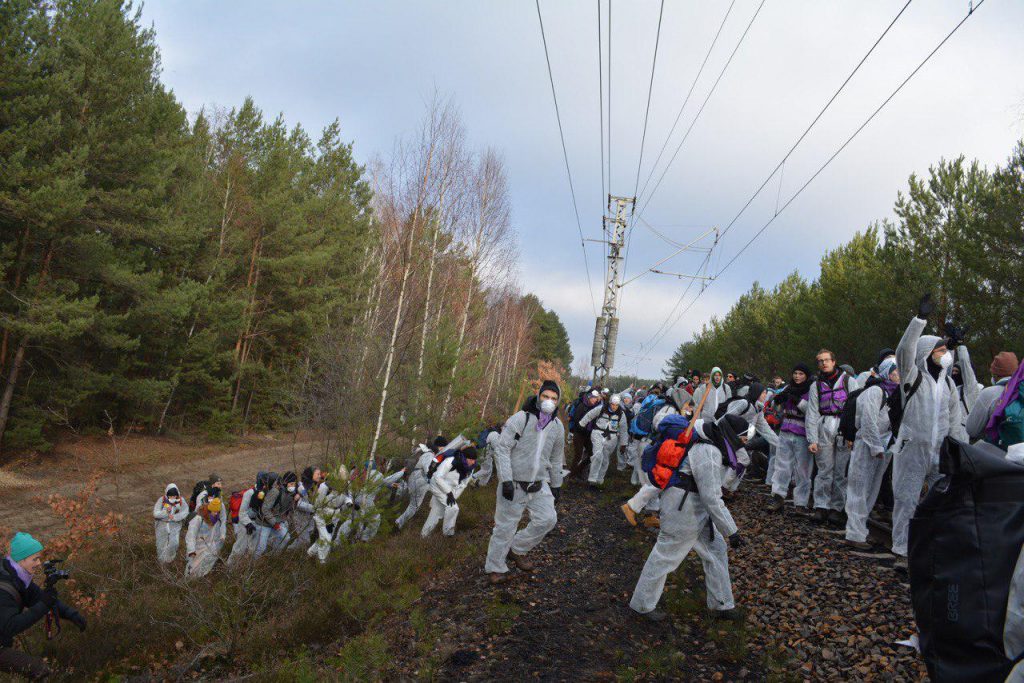
The next few hours drifted lazily by. The media appeared in large numbers; some with expensive looking cameras and microphones, some with smartphones and selfie sticks. One woman approached me with a camera man and thrust a microphone in my face; ‘what’s your motivation for being here?’ she asked. Caught unaware by the questioning I responded, quite correctly, ‘to stop the normal production of coal for a day’. ‘And why are you doing that?’ A question that seemed to me so obvious that I had not given it much thought, ‘Erm, I guess cas we’ve pulled enough coal out of the earth already.’ What I perhaps should have said was ‘because the earth is burning, and we can’t stop adding fuel to the fire. This here is the fire, and we’re going to extinguish it.’ Probably would have been catchier for the 9 O’clock news. Maybe next time.
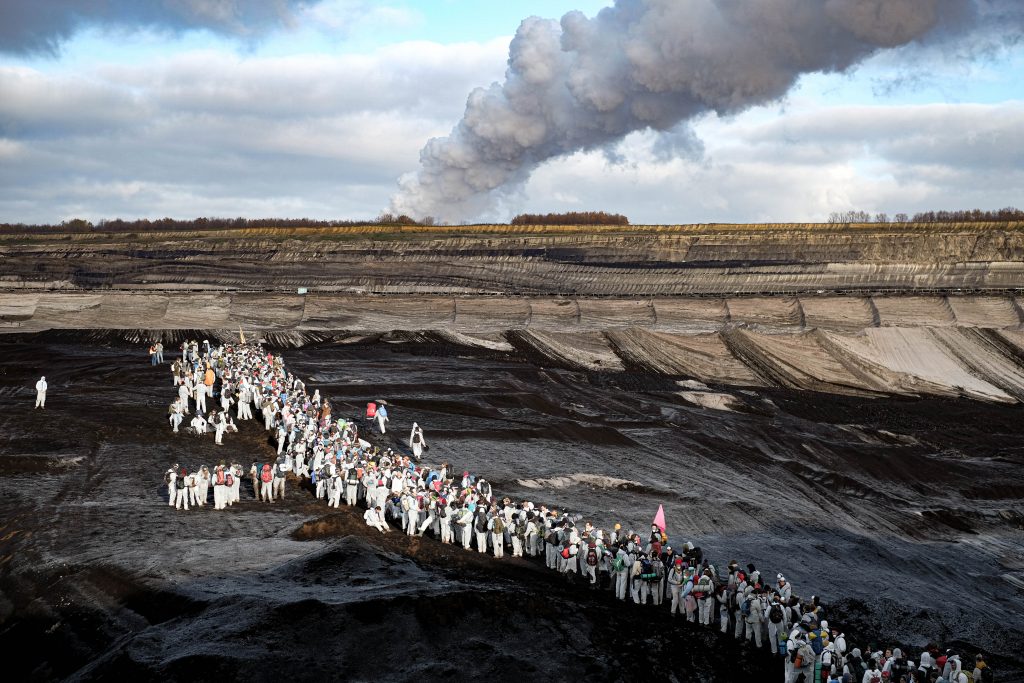
I sit down and meditate. Its a nice feeling. For the first time in days, I have nothing to do, nothing I can do, my thoughts slow down and I feel the air rising and descending through my body. I am no longer chasing after my thoughts, but instead letting them float away. Awaking from this, I feel the sudden urge to talk with the police that were encircling us. ‘Do you have an opinion on the topic of coal mining?’ I ask them. ‘When I’m at home, I do have an opinion’ would be the general answer ‘but not here, here I am working.’ But while they were unwilling to engage in debate, they were generally pretty friendly and mild mannered.

To the right side of our blockade is a thicket where people had already erected a make shift toilet for people to shit. Beyond that is a large lake, surrounded trees, bushes and herbs. It is a beautiful scene aside from the huge coal factories that lay on the far side. After walking around the lake for a little bit, I return to the camp to find a tai chi workshops taking place. A little further along was a group of people dancing around someone holding a portable speaker playing techno. A person with a megaphone reports of the other fingers; three fingers made it into the pit, and the green-purple finger was successfully blocking the tracks on the other side. My Bezugsgruppe sit for a little picnic, sharing around tea, nuts and biscuits. The call goes out for a second plenum; this time about how we would make our way home. Although we are not blocking the regular train tracks (just the coal tracks beside them) Deutsche Bahn had interrupted their train service in the small town beside where we were.
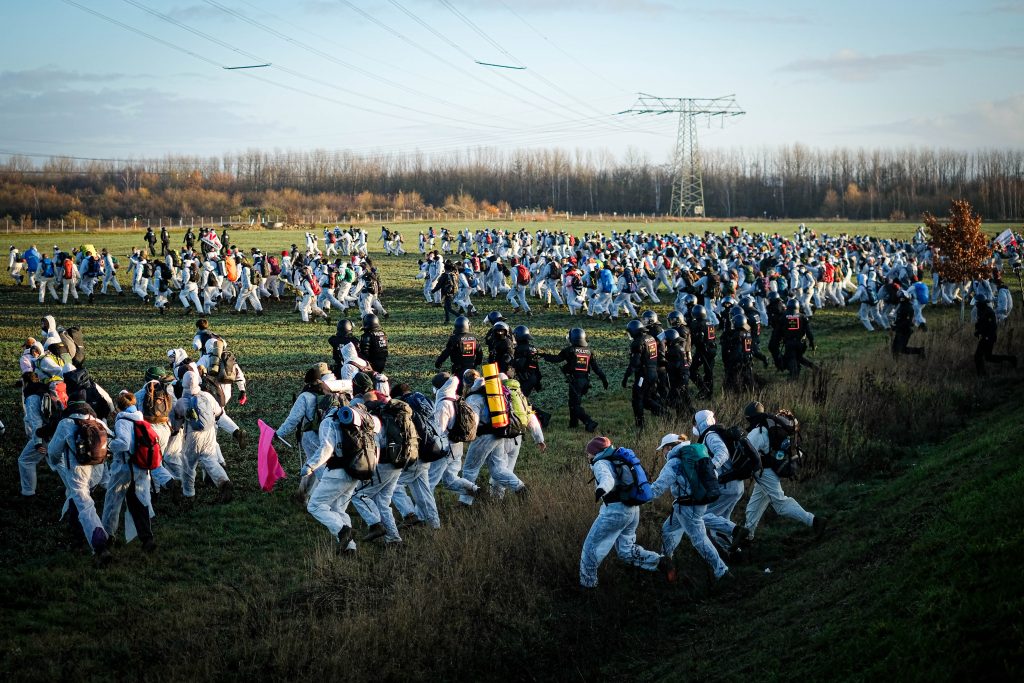
Our options are to walk three hours to Kottbus, or wait at the little train station without knowing when, or if, a train would arrive. What is clear is that we have to move before it gets dark. In East German in general, and Saxony in particular, there are a lot of Nazis. The far right AFD are on the rise, and the neo-Nazi movement has a definitive presence in the region. During the day we are too big a group for the Nazis to offer any serious threat, but in the confusion of night we are potentially in danger. A few people from the awareness team say they spotted a few suspicious characters they were unable to identify, and the threat of nazi attack hangs in the air. We decide that, as it was on the way anyway, we would walk by the train station and wait a few minutes. But if it seemed like the train wasn’t coming, we would head out onto the long road to Kotbus. The plenum representatives take this message back to the Bezugsgruppen, and we all begin to collect ourselves. On our way back to the train we are met by the kitchen team who had brought us warm pumpkin soup, bread, and fruit. We are all happy, and break bread, celebrating the successful action. It was dusk when we near the train station. We wait a little bit and get the message that the trains are back on. The train that pulled up was small, built for 200 people, and we were about 400. We all make ourselves close and cosy on the train. As we wait to depart the train station two angry looking masked young men were giving us the finger and filming us on their camera phones. I begin waving and blowing kisses, but someone asks me not to engage with nazis. Most people sleep on the way back, tired but happy about the days successful action.
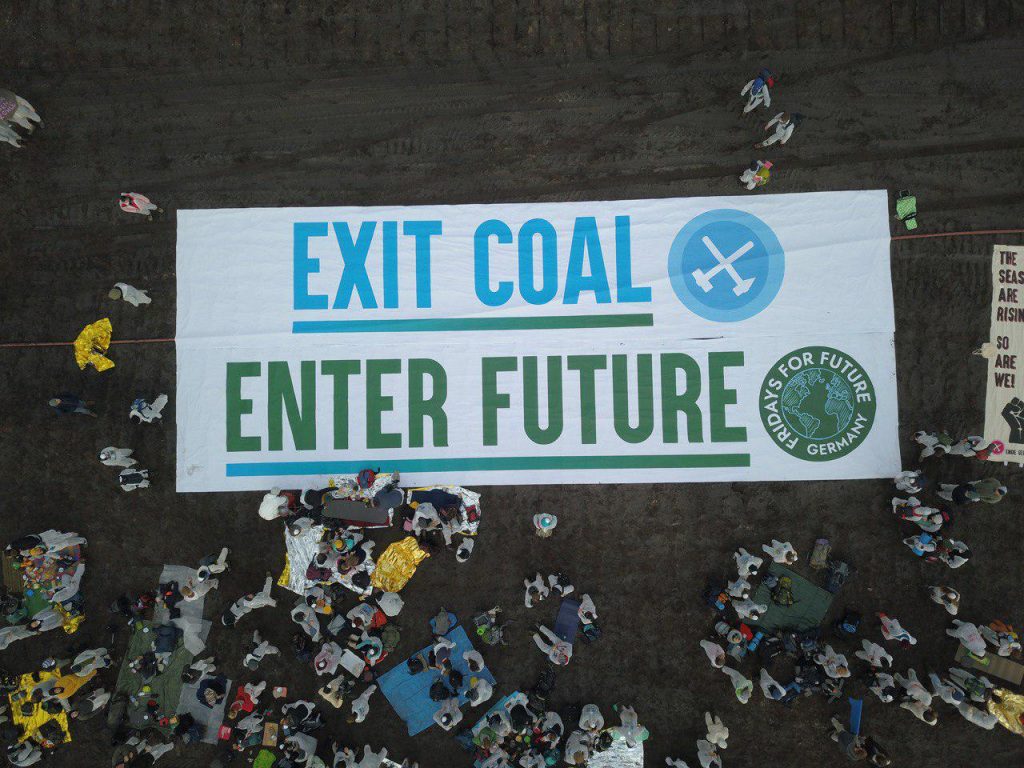
After
The next day we again assembled in the Kubiz to go over some of the events that happened in the previous day. During the action there were seven groups with a variety of objectives. Although we had brief reports of their successes, we knew very little of the course of events in the other fingers, so the next day was a chance to hear about the run of events from all groups. The after plenum was scheduled for 11, and by 12 it was decided that enough people were there that they could start. The moderator began by announcing that, for the first time at an Ende Gelände action, all groups had achieve their goal. It was a surprisingly easy and successful action. This was also the action with the least amount of planning and preparation, although that’s probably not the best lesson to be taken. After bringing out a big map and pointing at some of the actions, she invited people from the various fingers on stage to report a little bit on what happened.

The first person to speak was from the green-purple finger. The green-purple was the other half of the finger I was in, the orange-purple finger, and had the same objective as us – blocking the train tracks going in and out of the compound. However they were blocking the tracks on the other side of the compound and so had quite a different time of it than us. In the first place they had to be at the train station at 4’o clock (and it was said that of the 700 people that were the there the previous night, only 400 were there at 4, whether or not that was the deciding factor was unclear), to catch a train to Kottbus, where they were to take another train. Unfortunately, this train was not able to fit the 400 of them, and, not wanting to leave one half behind, they set out on a long hike to their destination. After a few hours, they suddenly turned off into a ditch and realised they were where they needed to be. At first the police tried to move them off the tracks, but gave up after a while. This meant that, along with our finger, all train lines going in and out of the compound were successfully blocked for the day.
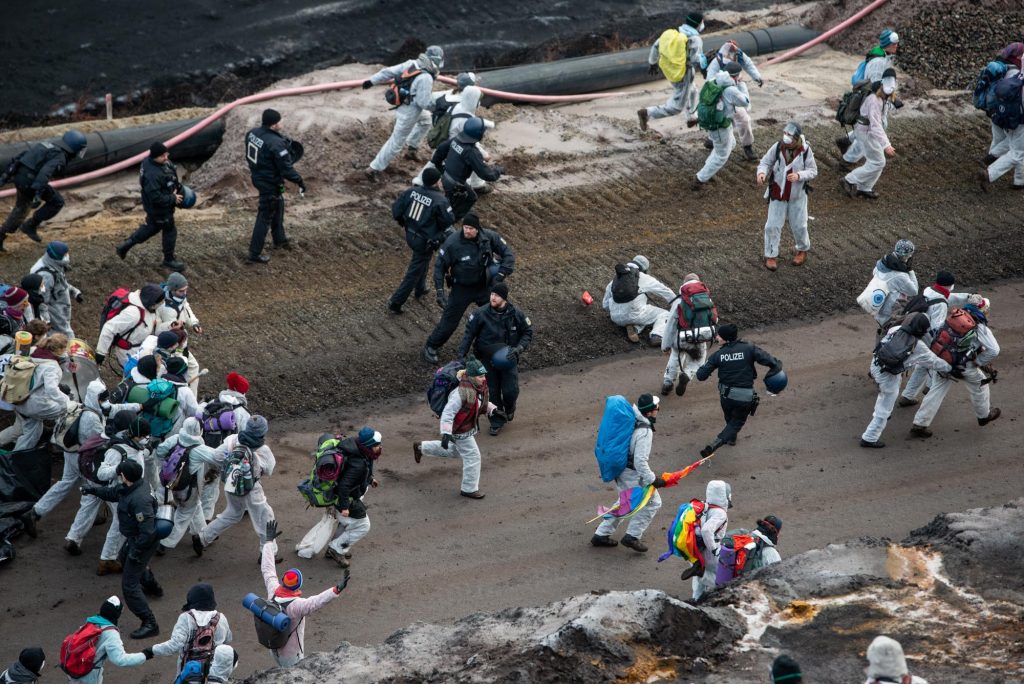
Next came the red finger. They had the mission of storming the pit, which they quickly achieved, being the first group to reach their goal. Very soon after getting off the train, they swerved off the road, and they found themselves in the pit. But this quick success provoked a strong police reaction, and while our finger was picnicking and doing tai chi, they were suffering from violent police repression. The fightback from police blocked their advance, hindered their movements, and forced a retreat. In the end they were surrounded by a police team, and made a human chain. This stand-off went on for a while until they were allowed to move a bit and thus communicate. A plenum was called to decide on the best course of action. The two options were – call it a day and return to Berlin, or break through the police lines and go back into the pit. The discussion was apparently a little heated, and the person giving the report expressed disappointment that the final decision was retreat. She said their was one person who was insisting that it was too dangerous and they had to go back. The person who was giving the report conceded that of course it was dangerous, but they already knew that on the way to the action. But group actions are done on a consensus basis, all must be in agreement or the action won’t go ahead. With a few feeling that breaking through the police lines was beyond what they felt comfortable with, they boarded the buses back to Berlin. So a successful action, if cut a little short.
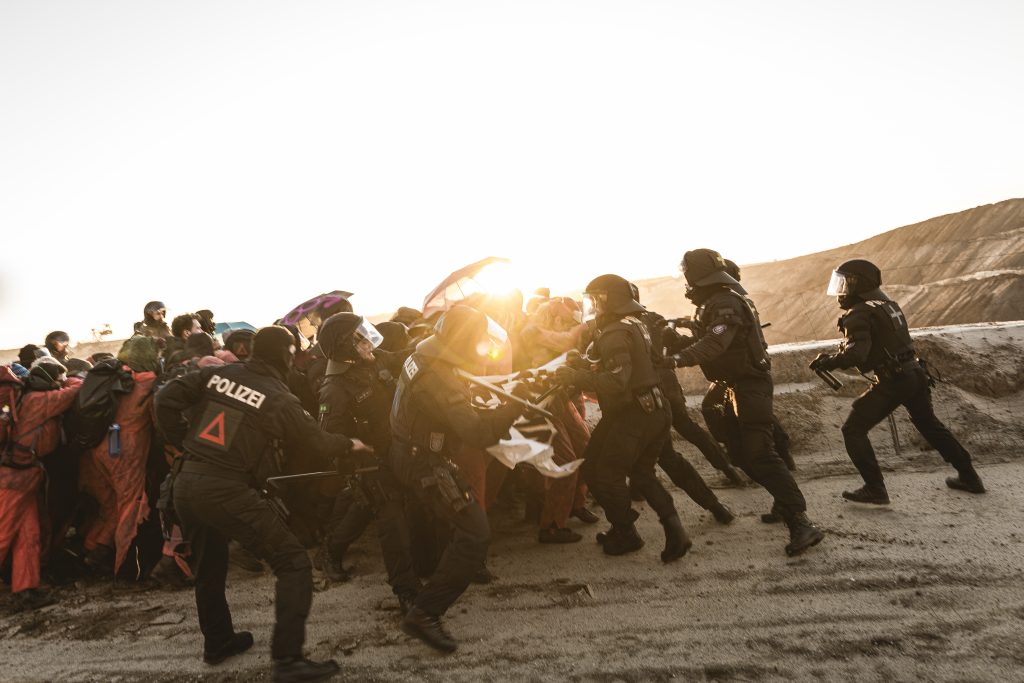
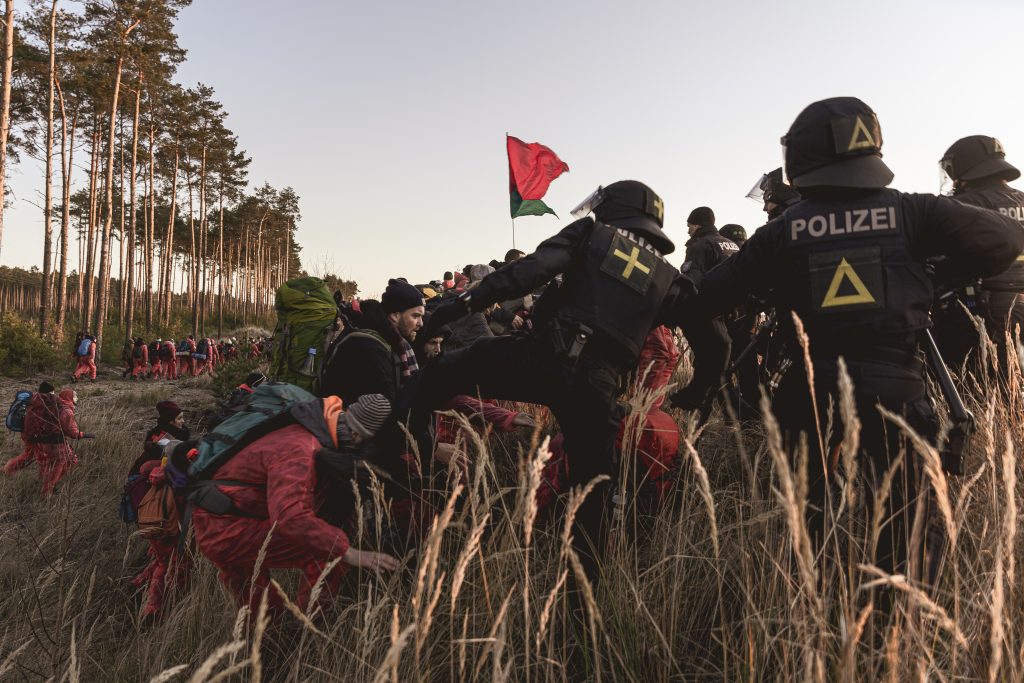
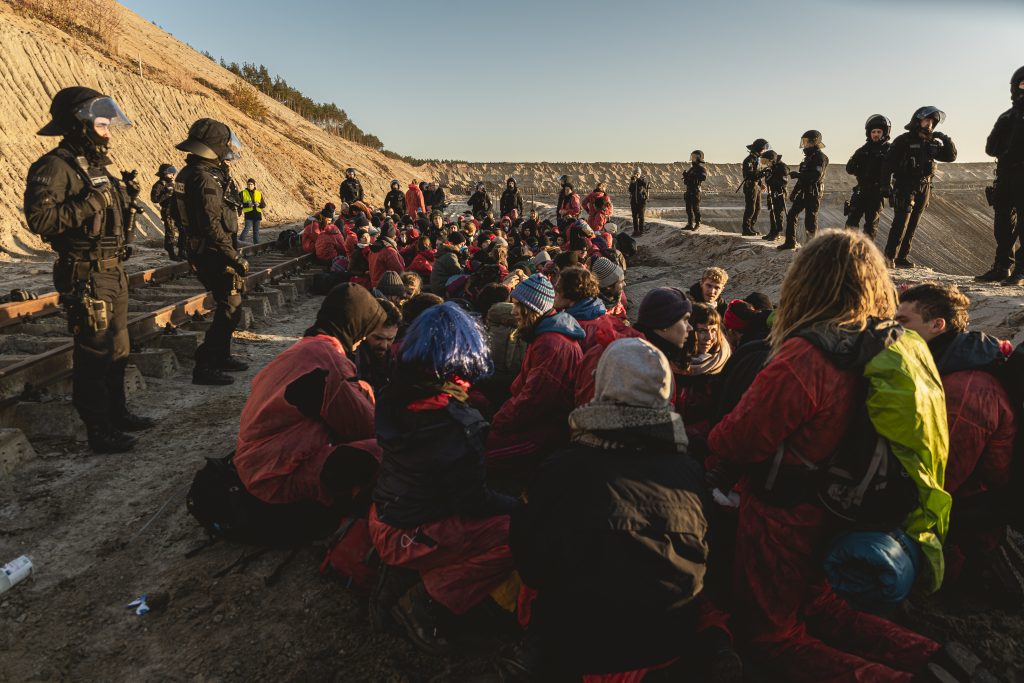
The next reports were from the Bunte Finger (colourful finger), a group of people who were more limited in their mobility, and the Anti-Kohle Kids (anti-coal kids), a group of teenage activists. This group successful blocked a train track and road connected with the coal compound. Along with the success of the action, the presence of these finger ensured a broad participation from the young, old, and people with disabilities. A video was shown of the Anti- Kohle Kids and, on the basis of this video, they were undoubtedly the most radical of the groups. Walking in tight formation, veiled in huge clouds of coloured smoke bombs, booming chants of ‘AHHH- ANTI- ANTI CAPITALISTA’, they no doubt struck fear in the heart off any police foolish enough to stand in their way. As dusk was approaching, they too had reports that there were ominous, unidentified figures spotted around the blockade, and with dusk approaching, and the threat of nazi attacks looming, they made their way back home.
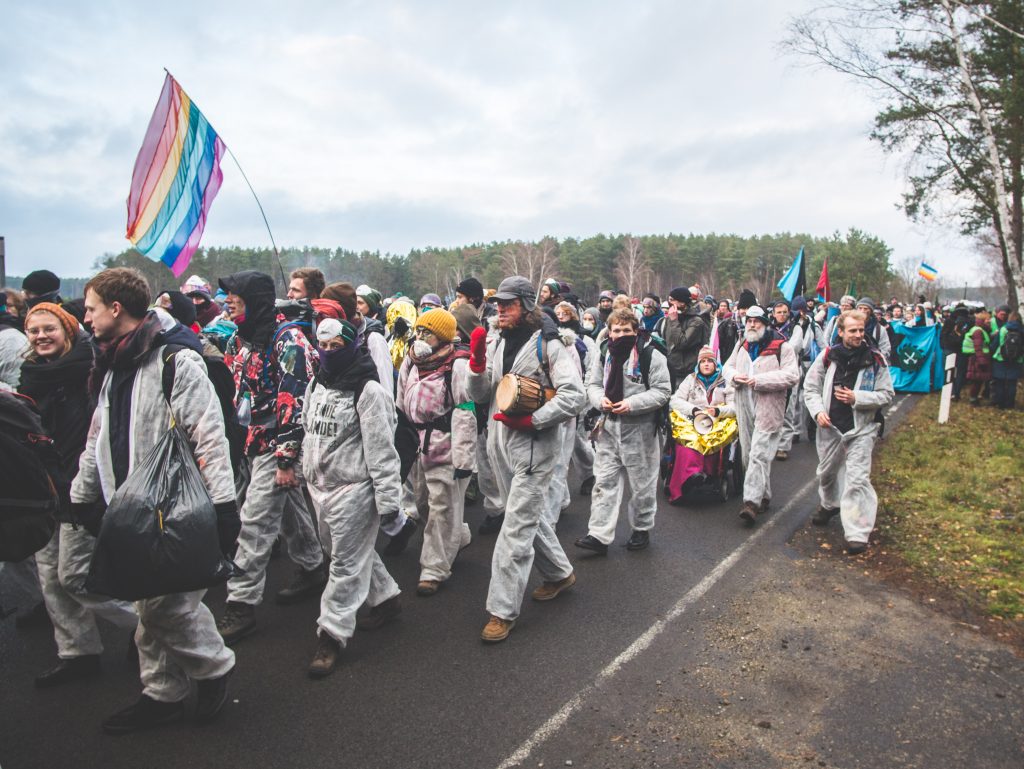
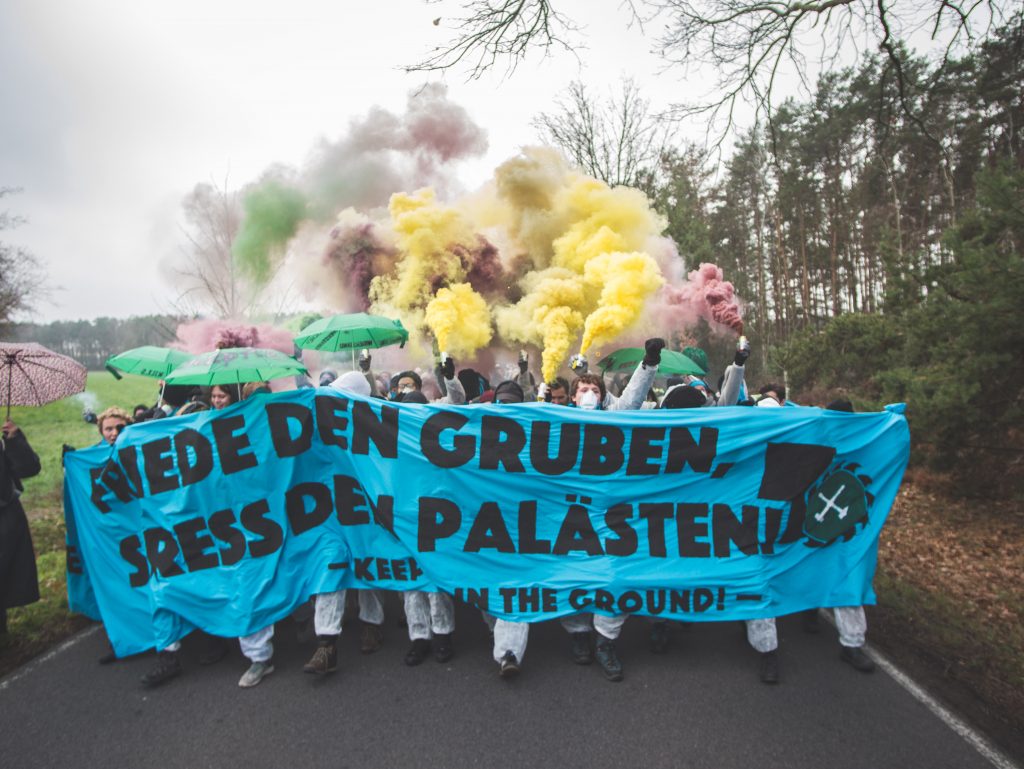
Finally, although no representatives were there from the Green and Gold fingers (being organised from Dresden and Leipzig) we did watch a spectacular drone video of the Gold finger. With a huge line of police vans attempting the finger, composed of at least a thousand people, they spread out and easily broke the line of the helpless police, who could do nothing but chase after the activists. Successfully having broken the line and getting into the pit, they once again formed the finger formation and marched triumphantly to the Bagger (excavator). Once they settled down unveiled a large banner ‘Exit Coal, Enter Future’. A few weeks later, at Hambacher Forst, I met someone who was part of this group. He said they had a relatively easy time of it. The first two hours by the extractor were chill. Like us on the train tracks they started to enjoy themselves, paint each others faces, feed and pet the police horses, but after a few hours they started to receive police repression. The police would start breaking up plenums and destroying any structures that were lying around (sometimes flinging the material at activists when doing so). Another group of police had planted themselves on the extractor and could observe everything from above. They were able to identify the people who were co-ordinating things, the structural team, and singled them out for repression and arrest. But aside from that the action successfully stayed until dusk, when they retreated back to Leipzig. My friend in Hambi said that he thought they should have stayed longer than the seven hours they were there, as they had prepared for up to 48 hours, but there will be more chances in the future for longer actions. We didn’t hear much from the green finger aside from that they too made it successfully into the pit, and a picture of them in a huge double circular formation.
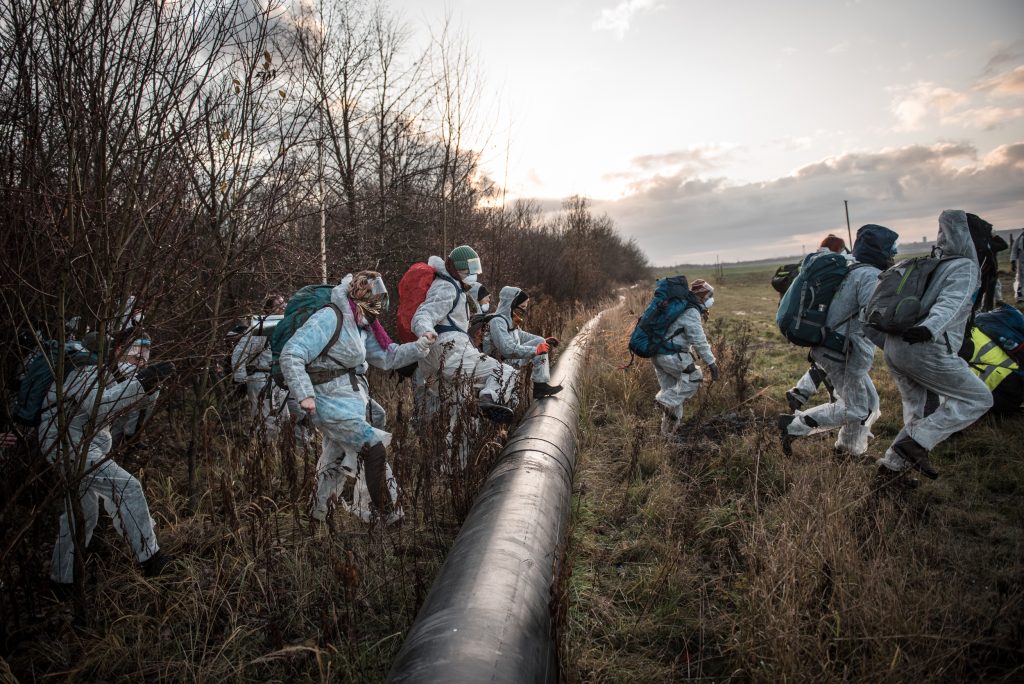
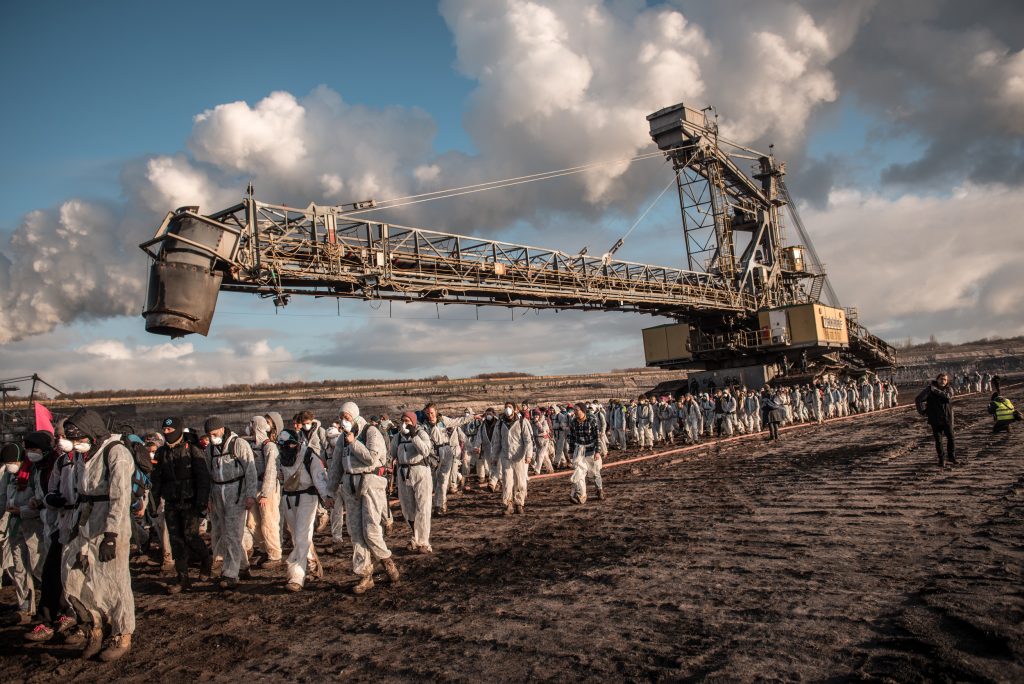
A final report we heard was of six activists who got arrested before even making it to the action. On their way to the train station on the morning of the action they were caught on the U-bahn without tickets. On the way to the action, these people had no ID on them and refused to give their identity. So determined were they that they even chopped off the first layered of their finger so that their prints couldn’t be taken (a common enough measure for people going to high risk actions). This situation spooked the ticker collector enough that she rang the Bundespolizei (the federal police), who arrived to take them to a police station. They were held there for six hours but refused to give personal details. After 6 hours the Polizei, probably a little confused as to why these people were going to such lengths to avoid a fine for fair evasion, let them go without finding out their identities.
For more information: https://www.ende-gelaende.org/
1) https://www.cleanenergywire.org/factsheets/coal-germany